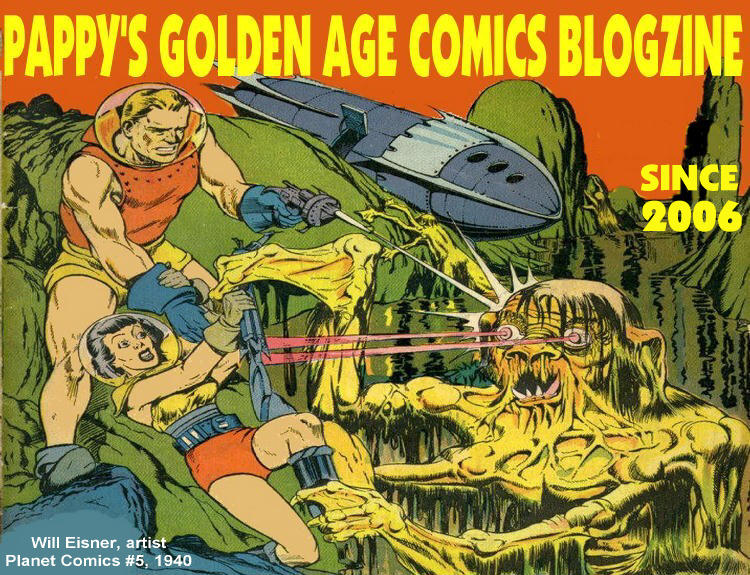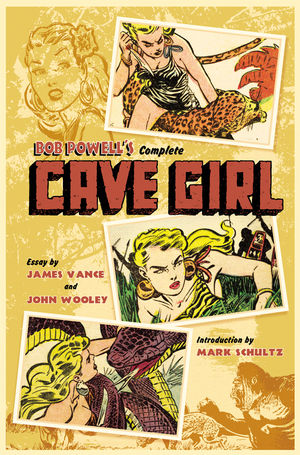“The Thing From the Sea” looks a lot like an EC story of the same era. But it is from Avon Comics’ Eerie #2 (1951). The plot of a dead person coming back to wreak revenge on his murderer is a cliché, but the art treatment here is first class. Wallace Wood’s distinctive style distinguishes this story, beginning with the striking inside front cover, deftly illustrated on coquille board.
Jim Vadenboncoeur Jr gives credit for the inside cover to Wood and Sid Check, and for the story to Wood, Joe Orlando and Check.
Translate
Friday, February 27, 2015
Wednesday, February 25, 2015
Number 1701: Cave Girl glows
Even without looking at the date of Cave Girl #12, (which is 1953, by the way), you can tell it is of another era. The cliché of fooling the “ignorant” natives by making them think the supernatural is at work is used, and a radium dial watch figures into the plot.
I read about radium dials. For safety concerns and by law their manufacture was ended in the late 1950s. I have a box of my late father’s cigarette lighters, tie pins, rings and wristwatches, most from the 1940s and '50s. After dark on a recent evening I turned out the room lights to see if any of the dials glowed. Thankfully none did. In this story, written by Gardner Fox and drawn by Bob Powell and his assistants, a radium dial and a geiger counter make a crude GPS for tracking the bad guys.
UPDATE: I can’t keep up with all the great reprints of Golden Age material. After posting this, I found out Dark Horse has an archive edition of the complete Cave Girl adventures. Just click on the thumbnail to be taken to the Dark Horse site for information.
I read about radium dials. For safety concerns and by law their manufacture was ended in the late 1950s. I have a box of my late father’s cigarette lighters, tie pins, rings and wristwatches, most from the 1940s and '50s. After dark on a recent evening I turned out the room lights to see if any of the dials glowed. Thankfully none did. In this story, written by Gardner Fox and drawn by Bob Powell and his assistants, a radium dial and a geiger counter make a crude GPS for tracking the bad guys.
UPDATE: I can’t keep up with all the great reprints of Golden Age material. After posting this, I found out Dark Horse has an archive edition of the complete Cave Girl adventures. Just click on the thumbnail to be taken to the Dark Horse site for information.
Monday, February 23, 2015
Number 1700: Giving Nebird de bird
When I saw the Pete Nebird byline on this Black Owl story from Prize Comics #6 (1940), I did a double-take. Not that comic book bylines of the thirties and forties can be trusted, since pseudonyms were more the norm than exception, but Nebird is Driben reversed.* Peter Driben, the world famous pin-up artist, that is. One look at the artwork of the Black Owl story disabused me of any notion that Driben had anything to do with it. Here is a Driben magazine cover from 1938:
Going to the Grand Comics Database, they give credit for the Black Owl artwork to Pete Riss and Jack Binder. Mystery solved. Besides Nebird being Driben backwards, it is also an anagram of Binder.
*It was the late Don Thompson who said (and I'm paraphrasing), comic book readers learn early on to read backwards.
Going to the Grand Comics Database, they give credit for the Black Owl artwork to Pete Riss and Jack Binder. Mystery solved. Besides Nebird being Driben backwards, it is also an anagram of Binder.
*It was the late Don Thompson who said (and I'm paraphrasing), comic book readers learn early on to read backwards.
Friday, February 20, 2015
Number 1699: George Washington bites!
George Washington’s birthday is in a couple of days. Happy 283rd birthday, Mr. President!
In this tale from Herbie #8 (1965), Herbie’s version of the American Revolution’s beginning is told. Herbie and his time-traveling lollipop show us the revolution began over George Washington’s false teeth. Herbie mounts up to replace Paul Revere on the famous ride...even if, as the panel on top of this page shows, his timing is sometimes off.
In this tale from Herbie #8 (1965), Herbie’s version of the American Revolution’s beginning is told. Herbie and his time-traveling lollipop show us the revolution began over George Washington’s false teeth. Herbie mounts up to replace Paul Revere on the famous ride...even if, as the panel on top of this page shows, his timing is sometimes off.
Wednesday, February 18, 2015
Number 1698: Natch Kilroy’s unformed teenage brain
During my teen years my dad, Big Pappy, aimed several variations on a well-worn cliché at me: “You’d forget your head if it wasn’t glued/bolted/nailed/screwed on!” The splash panel for this story from The Kilroys #3 (1947) brings back that memory. Big Pappy died years before science came out with news that a teenage brain is not yet done; it is still maturing about the time our bodies get large enough to fool people into thinking we should be wiser than we really are.
Bob Wickersham (art) and Hubie Karp (story) give us more funny teenage tales, close to situations I encountered during my own teenage unformed brain years. Yours too, I’ll bet.
“No Vacancies” is a story based on the postwar housing shortage. Returning veterans returned home where a place to live was hard to find.
The Kilroys get a television set in 1948! Just click on the thumbnail.
Bob Wickersham (art) and Hubie Karp (story) give us more funny teenage tales, close to situations I encountered during my own teenage unformed brain years. Yours too, I’ll bet.
“No Vacancies” is a story based on the postwar housing shortage. Returning veterans returned home where a place to live was hard to find.
The Kilroys get a television set in 1948! Just click on the thumbnail.
Subscribe to:
Posts (Atom)




















































